Global Maps of Avian Leukosis Viruses: Research Trends and Themes Based on Networking
Abstract
Simple Summary
Abstract
1. Introduction
2. Materials and Methods
2.1. Data Mining
2.2. The Inclusion and Exclusion Criteria of Data
2.3. Bibliometric Analysis
3. Results
3.1. Persuasive Research Journal/Sources
3.2. Scientifically Contributing Countries and Organizations in Terms of ALV Research
3.3. Most Cited Documents/Articles
3.4. The Authorship Analysis
3.5. ALV Research Trends and Themes Based on the Co-Occurrence of Author-Provided Keywords
3.6. Three-Factor Analysis
3.7. Global Collaboration Map on ALV Research
4. Discussion
5. Conclusions
Author Contributions
Funding
Institutional Review Board Statement
Informed Consent Statement
Data Availability Statement
Acknowledgments
Conflicts of Interest
References
- Hu, X.; Chen, S.; Jia, C.; Xue, S.; Dou, C.; Dai, Z.; Xu, H.; Sun, Z.; Geng, T.; Cui, H. Gene expression profile and long non-coding RNA analysis, using RNA-Seq, in chicken embryonic fibroblast cells infected by avian leukosis virus J. Arch. Virol. 2018, 163, 639–647. [Google Scholar] [CrossRef] [PubMed]
- Feng, M.; Zhang, X. Immunity to Avian Leukosis Virus: Where Are We Now and What Should We Do? Front. Immunol. 2016, 7, 624. [Google Scholar] [CrossRef]
- Nair, V. Tumors of the Avian Immune System. In Avian Immunology; Davison, F., Kaspers, B., Schat, K.A., Eds.; Academic Press: London, UK, 2008; pp. 359–372. [Google Scholar]
- Koslova, A.; Kucerova, D.; Reinisova, M.; Geryk, J.; Trefil, P.; Hejnar, J. Genetic Resistance to Avian Leukosis Viruses Induced by CRISPR/Cas9 Editing of Specific Receptor Genes in Chicken Cells. Viruses 2018, 10, 605. [Google Scholar] [CrossRef] [PubMed]
- Li, D.; Qin, L.; Gao, H.; Yang, B.; Liu, W.; Qi, X.; Wang, Y.; Zeng, X.; Liu, S.; Wang, X.; et al. Avian leukosis virus subgroup A and B infection in wild birds of Northeast China. Vet. Microbiol. 2013, 163, 257–263. [Google Scholar] [CrossRef] [PubMed]
- Shittu, I.; Adedeji, A.J.; Luka, P.D.; Asala, O.O.; Sati, N.M.; Nwagbo, I.O.; Chinyere, C.N.; Arowolo, O.O.; Adole, J.A.; Emennaa, P.; et al. Avian leukosis virus subgroup—J as a contaminant in live commercially available poultry vaccines distributed in Nigeria. Biologicals 2019, 57, 29–33. [Google Scholar] [CrossRef] [PubMed]
- Cui, N.; Su, S.; Chen, Z.; Zhao, X.; Cui, Z. Genomic sequence analysis and biological characteristics of a rescued clone of avian leukosis virus strain JS11C1, isolated from indigenous chickens. J. Gen. Virol. 2014, 95, 2512–2522. [Google Scholar] [CrossRef]
- Justic, J.; Beemon, K.L. Avian retroviral replication. Curr. Opin. Virol. 2013, 3, 664–669. [Google Scholar] [CrossRef]
- Rubin, H. The early history of tumor virology: Rous, RIF, and RAV. Proc. Natl. Acad. Sci. USA 2011, 108, 14389–14396. [Google Scholar] [CrossRef]
- Feng, M.; Xie, T.; Li, Y.; Zhang, N.; Lu, Q.; Zhou, Y.; Shi, M.; Sun, J.; Zhang, X. A balanced game: Chicken macrophage response to ALV-J infection. Vet. Res. 2019, 50, 20. [Google Scholar] [CrossRef]
- Zaib, G.; Cui, H.; Hu, X. Global network mapping research landscape and trends of the endogenous retroviruses: A look through bibliometric analysis. Rend. Lincei. Sci. Fis. Nat. 2022, 33, 663–672. [Google Scholar] [CrossRef]
- Csizmadia, T.; Katona, A.I. A global database for conducting systematic reviews and meta-analyses in innovation and quality management. Sci. Data 2022, 9, 301. [Google Scholar] [CrossRef]
- van der Wouden, P.; van der Heijden, G.; Shemesh, H.; van den Besselaar, P. Evidence and consequences of academic drift in the field of dental research: A bibliometric analysis 2000–2015. BDJ Open 2022, 8, 3. [Google Scholar] [CrossRef]
- Bender, M.E.; Edwards, S.; von Philipsborn, P.; Steinbeis, F.; Keil, T.; Tinnemann, P. Using Co-authorship Networks to Map and Analyse Global Neglected Tropical Disease Research with an Affiliation to Germany. PLoS Negl. Trop. Dis. 2015, 9, e0004182. [Google Scholar] [CrossRef]
- Newman, M.E. Coauthorship networks and patterns of scientific collaboration. Proc. Natl. Acad. Sci. USA 2004, 101, 5200–5205. [Google Scholar] [CrossRef]
- van Eck, N.J.; Waltman, L. Visualizing Bibliometric Networks. In Measuring Scholarly Impact: Methods and Practice; Ding, Y., Rousseau, R., Wolfram, D., Eds.; Springer International Publishing: New York, NY, USA, 2014; pp. 285–320. [Google Scholar]
- Ju, Y.; Long, H.; Zhao, P.; Xu, P.; Sun, L.; Bao, Y.; Yu, P.; Zhang, Y. The top 100 cited studies on bacterial persisters: A bibliometric analysis. Front. Pharmacol. 2022, 13, 1001861. [Google Scholar] [CrossRef]
- van Eck, N.J.; Waltman, L. Citation-based clustering of publications using CitNetExplorer and VOSviewer. Scientometrics 2017, 111, 1053–1070. [Google Scholar] [CrossRef]
- Fonseca, B.D.; Sampaio, R.B.; Fonseca, M.V.; Zicker, F. Co-authorship network analysis in health research: Method and potential use. Health Res. Policy Syst. 2016, 14, 34. [Google Scholar] [CrossRef]
- Biscaro, C.; Giupponi, C. Co-authorship and bibliographic coupling network effects on citations. PLoS ONE 2014, 9, e99502. [Google Scholar] [CrossRef]
- Crowley, D.M.; Scott, J.T.; Long, E.C.; Green, L.; Israel, A.; Supplee, L.; Jordan, E.; Oliver, K.; Guillot-Wright, S.; Gay, B.; et al. Lawmakers’ use of scientific evidence can be improved. Proc. Natl. Acad. Sci. USA 2021, 118, e2012955118. [Google Scholar] [CrossRef]
- Al-Jabi, S.W. Global research trends in West Nile virus from 1943 to 2016: A bibliometric analysis. Glob. Health 2017, 13, 55. [Google Scholar] [CrossRef]
- Farooq, R.K.; Rehman, S.U.; Ashiq, M.; Siddique, N.; Ahmad, S. Bibliometric analysis of coronavirus disease (COVID-19) literature published in Web of Science 2019–2020. J. Fam. Community Med. 2021, 28, 1–7. [Google Scholar]
- Wiethoelter, A.K.; Beltran-Alcrudo, D.; Kock, R.; Mor, S.M. Global trends in infectious diseases at the wildlife-livestock interface. Proc. Natl. Acad. Sci. USA 2015, 112, 9662–9667. [Google Scholar] [CrossRef] [PubMed]
- Morel, C.M.; Serruya, S.J.; Penna, G.O.; Guimaraes, R. Co-authorship network analysis: A powerful tool for strategic planning of research, development and capacity building programs on neglected diseases. PLoS Negl. Trop. Dis. 2009, 3, e501. [Google Scholar] [CrossRef] [PubMed]
- Yi, F.; Yang, P.; Sheng, H. Tracing the scientific outputs in the field of Ebola research based on publications in the Web of Science. BMC Res. Notes 2016, 9, 221. [Google Scholar] [CrossRef] [PubMed]
- Petersen, A.M. Quantifying the impact of weak, strong, and super ties in scientific careers. Proc. Natl. Acad. Sci. USA 2015, 112, E4671–E4680. [Google Scholar] [CrossRef]
- Albuquerque, P.C.; Castro, M.J.; Santos-Gandelman, J.; Oliveira, A.C.; Peralta, J.M.; Rodrigues, M.L. Bibliometric Indicators of the Zika Outbreak. PLoS Negl. Trop. Dis. 2017, 11, e0005132. [Google Scholar] [CrossRef]
- Radicchi, F.; Fortunato, S.; Castellano, C. Universality of citation distributions: Toward an objective measure of scientific impact. Proc. Natl. Acad. Sci. USA 2008, 105, 17268–17272. [Google Scholar] [CrossRef]
- Koo, M. A bibliometric analysis of two decades of aromatherapy research. BMC Res. Notes 2007, 10, 46. [Google Scholar] [CrossRef]
- Sweileh, W.M.; Al-Jabi, S.W.; Sawalha, A.F.; AbuTaha, A.S.; Zyoud, S.H. Bibliometric analysis of publications on Campylobacter: (2000–2015). J. Health Popul. Nutr. 2016, 35, 39. [Google Scholar] [CrossRef]
- Hossain, M.M. Current status of global research on novel coronavirus disease (COVID-19): A bibliometric analysis and knowledge mapping. F1000Research 2020, 9, 374. [Google Scholar] [CrossRef]
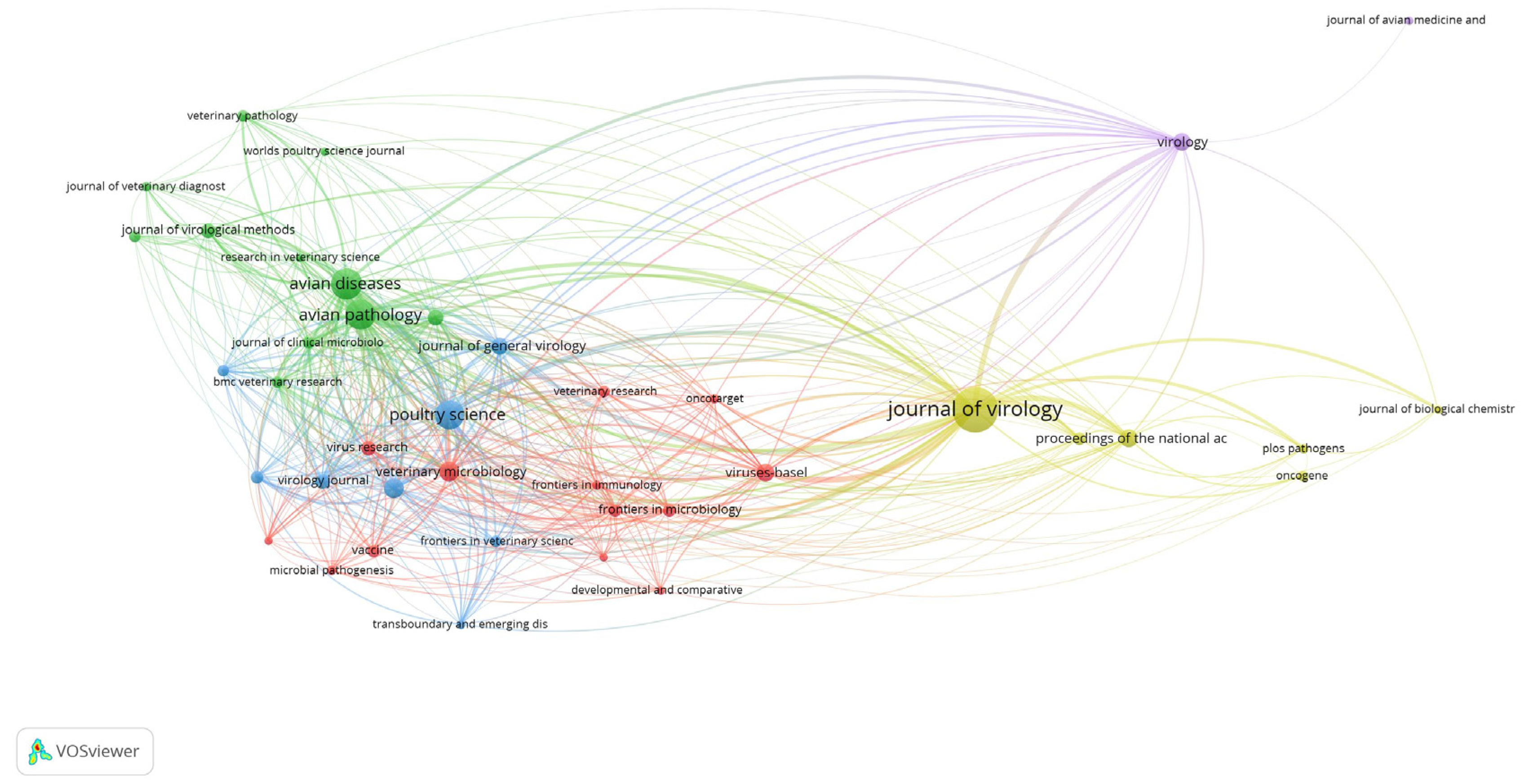
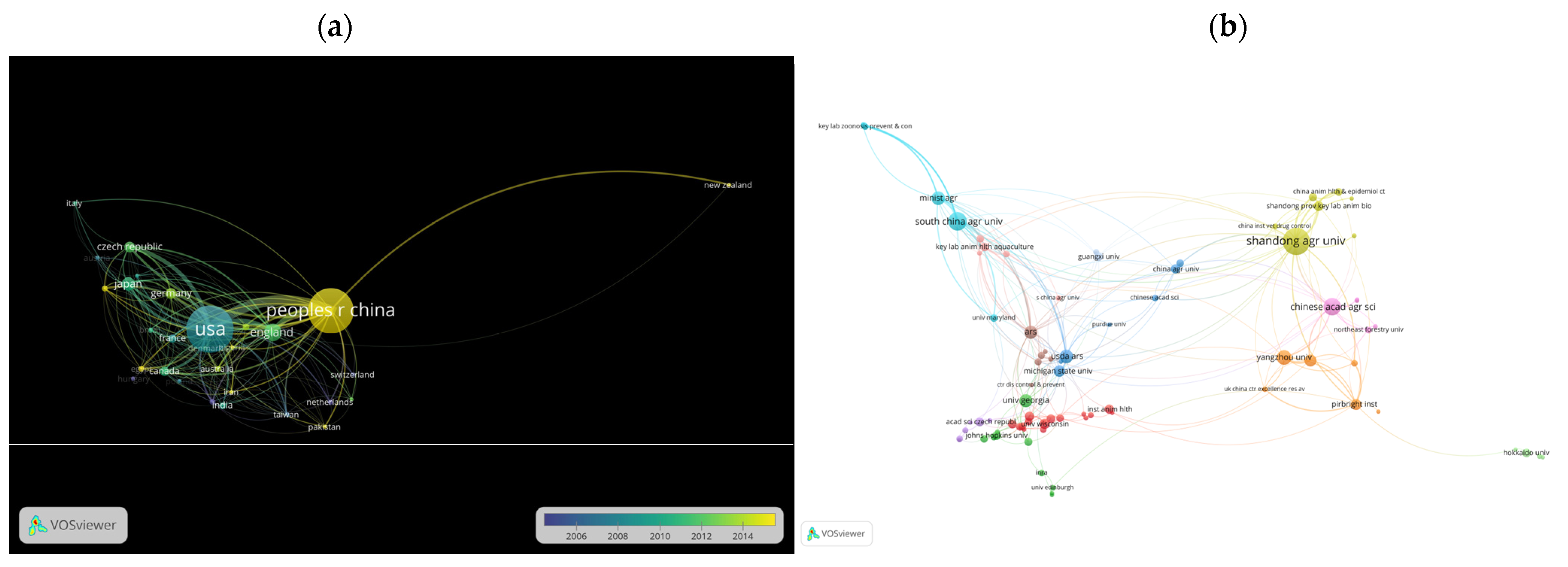
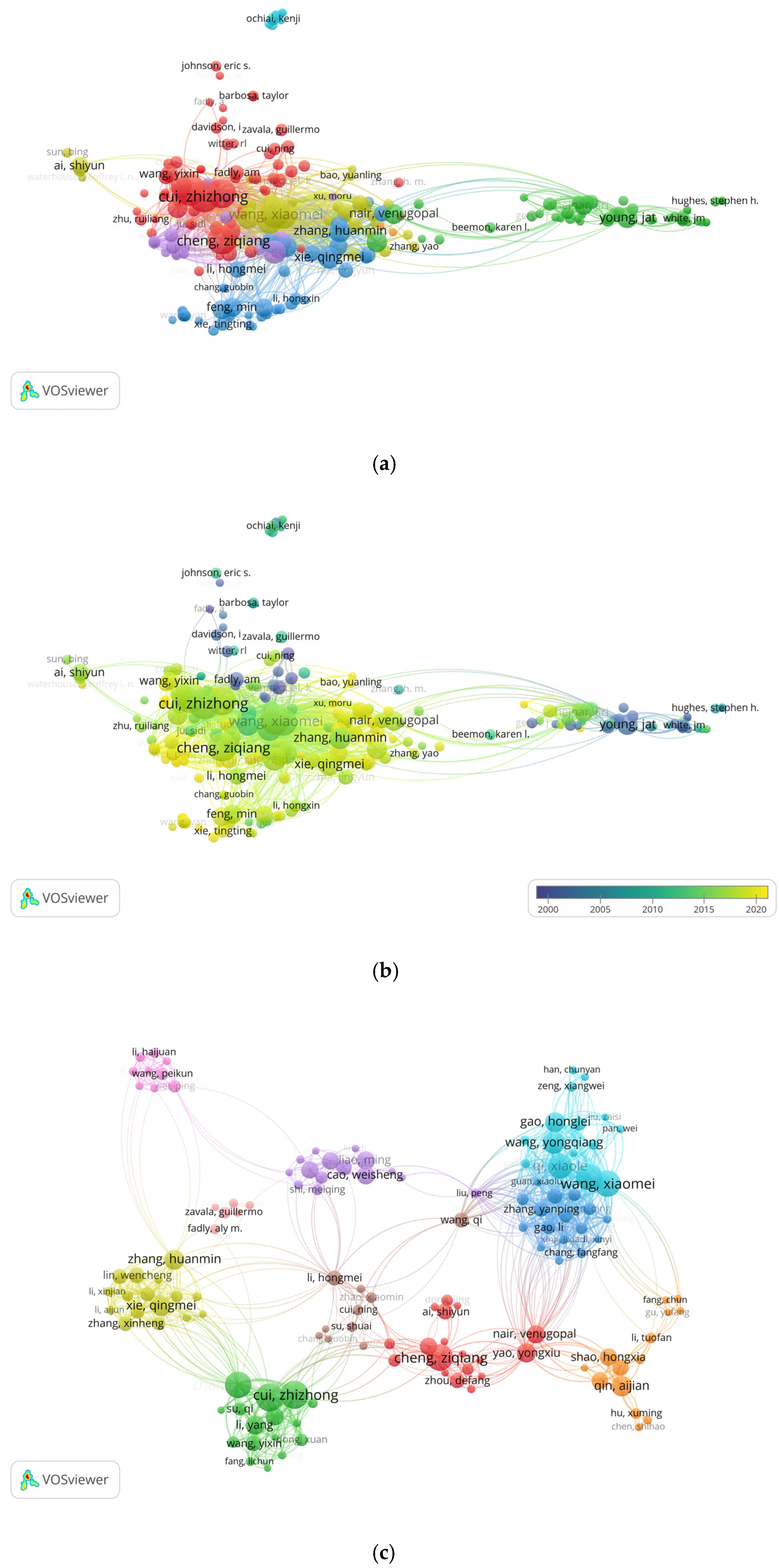

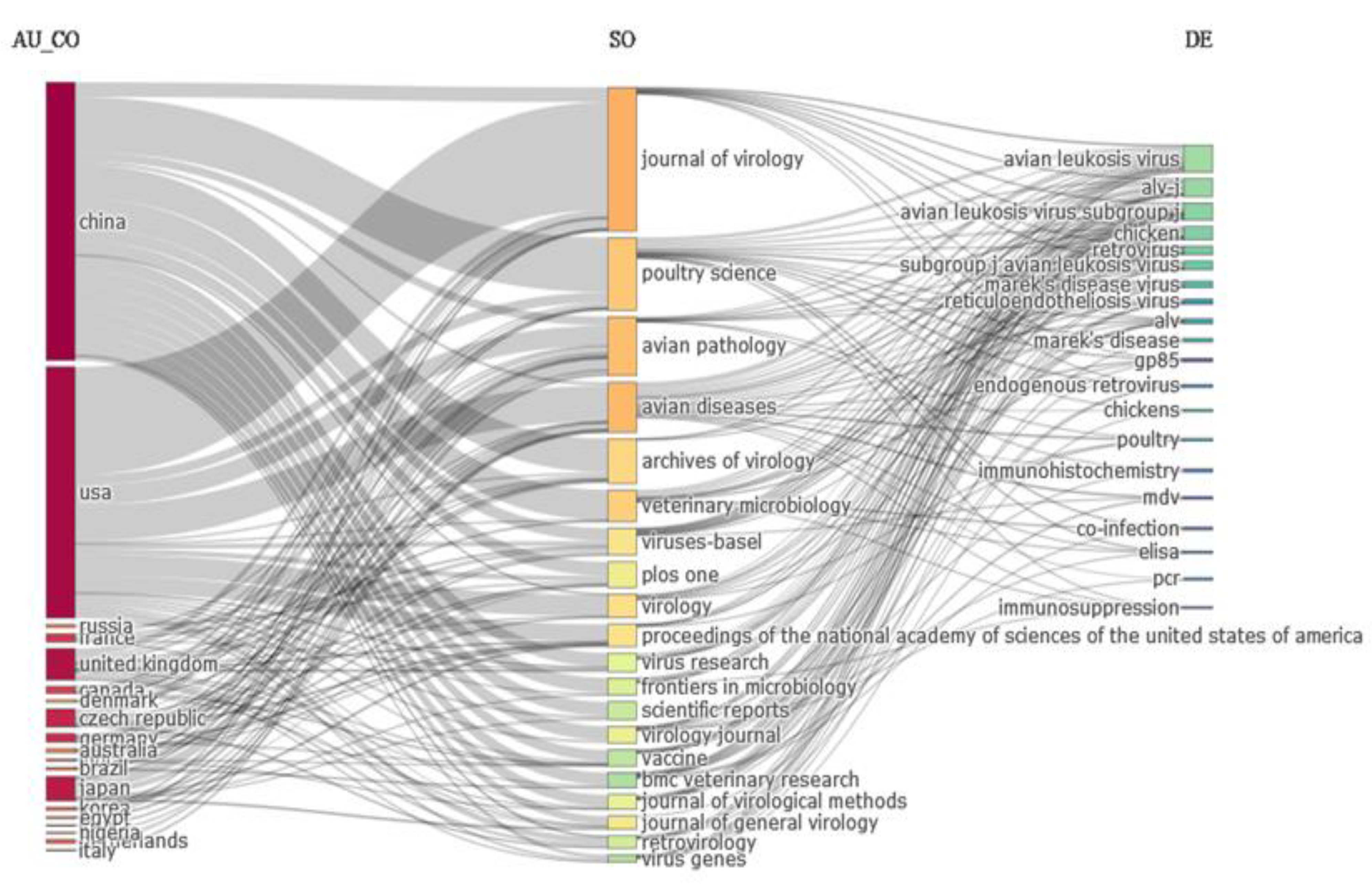
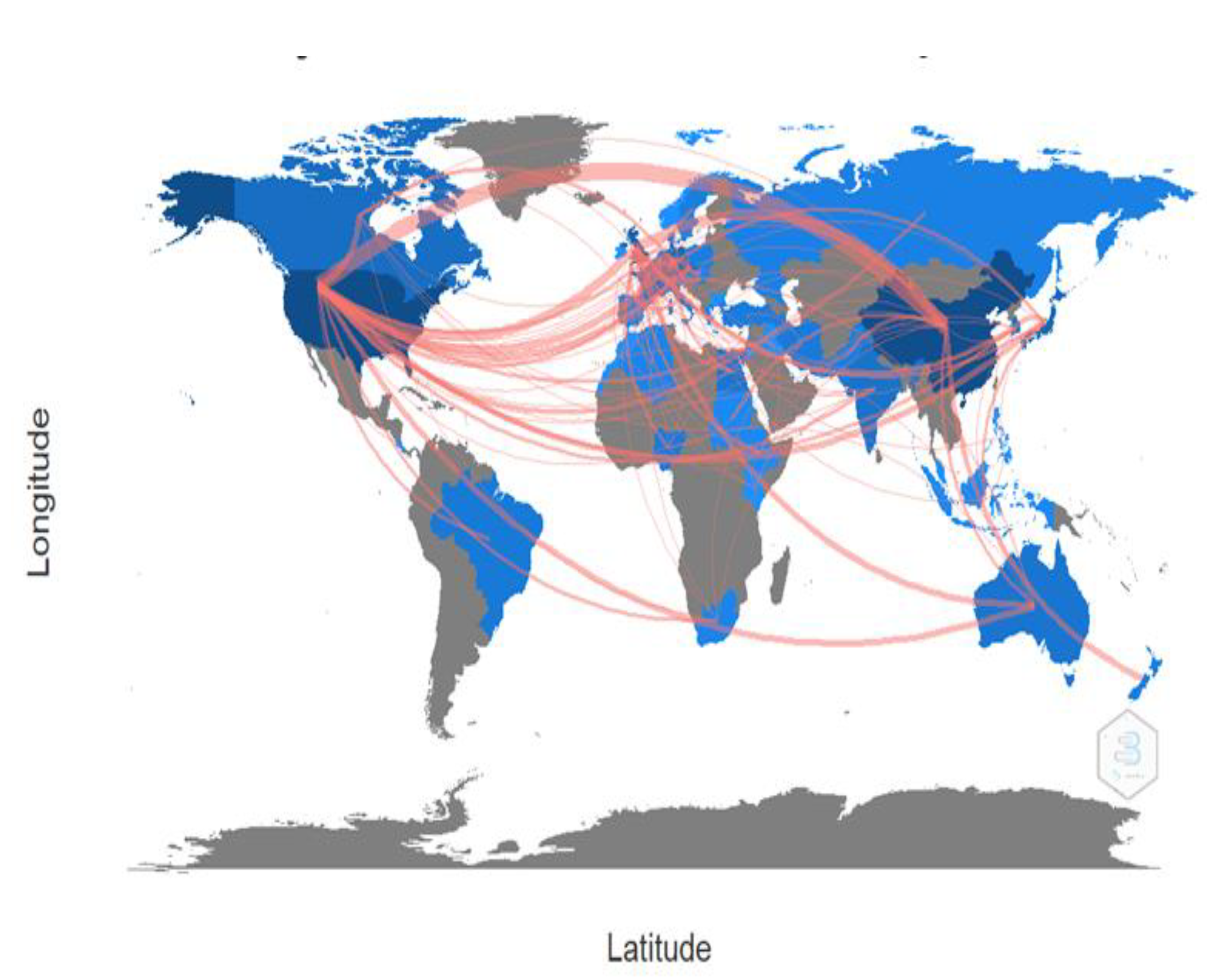
| Parameters | Sum | Frequency % | |
|---|---|---|---|
| Document Type | Article | 966 | 91.132 |
| Review Article | 64 | 6.038 | |
| Meeting Abstract | 14 | 1.321 | |
| Proceeding Papers | 9 | 0.849 | |
| Book Chapters | 7 | 0.660 | |
| Languages | English | 1049 | 98.962 |
| Hungarian | 3 | 0.283 | |
| Polish | 3 | 0.283 | |
| German | 2 | 0.189 | |
| Dutch | 1 | 0.094 | |
| Portuguese | 1 | 0.094 | |
| Turkish | 1 | 0.094 | |
| Research Areas | Virology | 314 | 29.623 |
| Veterinary Sciences | 305 | 28.774 | |
| Biochemistry Molecular Biology | 91 | 8.585 | |
| Agriculture | 89 | 8.396 | |
| Microbiology | 87 | 8.208 | |
| Biotechnology Applied Microbiology | 75 | 7.075 | |
| Science Technology Other Topics | 63 | 5.943 | |
| Immunology | 62 | 5.849 | |
| Genetics Heredity | 56 | 5.283 | |
| Cell Biology | 41 | 3.868 | |
| Ranks | Journals/Source | IF | TP | TC | TLS |
|---|---|---|---|---|---|
| 1 | Journal of Virology | 4.50 | 140 | 4574 | 929 |
| 2 | Avian Diseases | 1.73 | 66 | 1180 | 740 |
| 3 | Avian Pathology | 3.37 | 60 | 1307 | 807 |
| 4 | Poultry Science | 3.19 | 57 | 706 | 581 |
| 5 | Veterinary Microbiology | 3.29 | 27 | 341 | 417 |
| 6 | Archives of Virology | 2.57 | 26 | 337 | 337 |
| 7 | Virology | 3.61 | 22 | 554 | 278 |
| 8 | Proceedings of National Academy of Sciences | 11.20 | 21 | 1055 | 198 |
| 9 | Viruses-Basel | 4.91 | 21 | 167 | 257 |
| 10 | Journal of General Virology | 3.37 | 19 | 430 | 384 |
| Parameters | TP | TC | TLS | |
|---|---|---|---|---|
| Countries | USA | 443 | 13758 | 119 |
| Peoples R China | 419 | 4997 | 86 | |
| England | 76 | 1981 | 69 | |
| Japan | 45 | 431 | 16 | |
| Germany | 31 | 1335 | 39 | |
| Czech Republic | 31 | 384 | 14 | |
| Canada | 22 | 338 | 16 | |
| France | 19 | 367 | 19 | |
| India | 14 | 125 | 5 | |
| Scotland | 13 | 243 | 26 | |
| Research Institutions | Shandong Agricultural University | 162 | 2092 | 119 |
| South China Agricultural University | 73 | 774 | 142 | |
| Chinese Academy of Agricultural Sciences | 64 | 879 | 50 | |
| Yangzhou University | 48 | 460 | 49 | |
| United States Department of Agriculture USDA ARS | 42 | 1062 | 53 | |
| Ministry of Agriculture | 41 | 618 | 90 | |
| University of Georgia | 36 | 569 | 17 | |
| Michigan State University | 28 | 440 | 37 | |
| Pirbright Institute | 25 | 173 | 43 | |
| University of Wisconsin | 23 | 812 | 18 | |
| Title | Authors | Journals | IF | PY | TC | TC/Y | DOI | |
|---|---|---|---|---|---|---|---|---|
| 1 | Retroviral DNA integration: ASLV, HIV, and MLV show distinct target site preferences | Mitchell, R.S.; Beitzel, B.F.; Schroder, A.R.W.; Shinn, P.; Chen, H.M.; Berry, C.C.; Ecker, J.R.; Bushman, F.D. | Plos Biology | 9.59 | 2004 | 703 | 37 | 10.1371/journal.pbio.0020234 |
| 2 | The evolution, distribution and diversity of endogenous retroviruses | Gifford, R.; Tristem, M. | Virus Genes | 2.27 | 2003 | 264 | 13.2 | 10.1023/A:1024455415443 |
| 3 | Retroviral entry mediated by receptor priming and low pH triggering of an envelope glycoprotein | Mothes, W.; Boerger, A.L.; Narayan, S.; Cunningham, J.M.; Young, J.A.T. | Cell | 41.58 | 2000 | 249 | 10.83 | 10.1016/S0092-8674(00)00170-7 |
| 4 | The discovery of endogenous retroviruses | Weiss, Robin A. | Retrovirology | 4.18 | 2006 | 223 | 13.12 | 10.1186/1742-4690-3-67 |
| 5 | Viral Nucleic Acids in Live-Attenuated Vaccines: Detection of Minority Variants and an Adventitious Virus | Victoria, Joseph G.; Wang, Chunlin; Jones, Morris S.; Jaing, Crystal; McLoughlin, Kevin; Gardner, Shea; Delwart, Eric L. | Journal of Virology | 4.50 | 2010 | 220 | 16.92 | 10.1128/JVI.02690-09 |
| 6 | The long view: 40 years of avian leukosis research | Payne, L.N.; Nair, V. | Avian Pathology | 3.37 | 2012 | 198 | 18 | 10.1080/03079457.2011.646237 |
| 7 | A review of the development of chicken lines to resolve genes determining resistance to diseases | Bacon, L.D.; Hunt, H.D.; Cheng, H.H. | Poultry Science | 3.19 | 2000 | 168 | 7.3 | 10.1093/ps/79.8.1082 |
| 8 | Symmetrical base preferences surrounding HIV-1 and avian sarcoma/leukosis virus but not murine leukemia virus integration sites | Holman, A.G.; Coffin, J.M. | Proceedings of the National Academy of Sciences | 11.20 | 2005 | 135 | 7.5 | 10.1073/pnas.0501646102 |
| 9 | Development of a flexible and specific gene delivery system for production of murine tumor models | Fisher, G.H.; Orsulic, S.; Holland, E.; Hively, W.P.; Li, Y.; Lewis, B.C.; Williams, B.O.; Varmus, H.E. | Oncogene | 8.75 | 1999 | 124 | 5.17 | 10.1038/sj.onc.1203087 |
| Authors | Doc | TC | TLS | |
|---|---|---|---|---|
| The most cited author in the ALV | Young Jat | 28 | 1899 | 1506 |
| Callaway, Edward M | 5 | 1247 | 23 | |
| Cui Zhizhong | 50 | 824 | 4111 | |
| Li Y | 5 | 670 | 19 | |
| Wang Xiaomei | 44 | 644 | 4190 | |
| Gao Yulong | 43 | 644 | 4185 | |
| Qi Xiaole | 39 | 618 | 3879 | |
| Zhao Peng | 49 | 573 | 3472 | |
| Gao Honglei | 26 | 542 | 2864 | |
| Chang Shuang | 43 | 502 | 3228 | |
| Co-authorship analysis of scientists | Cui Zhizhong | 50 | 824 | 226 |
| Zhao Peng | 49 | 573 | 240 | |
| Wang Xiaomei | 44 | 644 | 379 | |
| Gao Yulong | 43 | 644 | 379 | |
| Chang Shuang | 43 | 502 | 229 | |
| Cheng Ziqiang | 43 | 479 | 116 | |
| Qi Xiole | 39 | 618 | 359 | |
| Wang Yongqiang | 33 | 599 | 269 | |
| Qin Aijian | 29 | 273 | 99 | |
| Gao Honglei | 26 | 542 | 186 | |
| No. | Keywords | Occurrence | Total Link Strength |
|---|---|---|---|
| 1 | avian leukosis virus | 94 | 101 |
| 2 | alv-j | 77 | 71 |
| 3 | avian leukosis virus subgroup j | 67 | 46 |
| 4 | Chicken | 65 | 96 |
| 5 | Retrovirus | 36 | 40 |
| 6 | Subgroup j avian leukosis virus | 29 | 30 |
| 7 | Marek’s disease virus | 22 | 30 |
| 8 | Marek’s disease | 21 | 42 |
| 9 | Reticuloendotheliosis virus | 18 | 27 |
| 10 | Endogenous retrovirus | 13 | 12 |
Disclaimer/Publisher’s Note: The statements, opinions and data contained in all publications are solely those of the individual author(s) and contributor(s) and not of MDPI and/or the editor(s). MDPI and/or the editor(s) disclaim responsibility for any injury to people or property resulting from any ideas, methods, instructions or products referred to in the content. |
© 2022 by the authors. Licensee MDPI, Basel, Switzerland. This article is an open access article distributed under the terms and conditions of the Creative Commons Attribution (CC BY) license (https://creativecommons.org/licenses/by/4.0/).
Share and Cite
Zaib, G.; Hu, X.; Cui, H. Global Maps of Avian Leukosis Viruses: Research Trends and Themes Based on Networking. Vet. Sci. 2023, 10, 16. https://doi.org/10.3390/vetsci10010016
Zaib G, Hu X, Cui H. Global Maps of Avian Leukosis Viruses: Research Trends and Themes Based on Networking. Veterinary Sciences. 2023; 10(1):16. https://doi.org/10.3390/vetsci10010016
Chicago/Turabian StyleZaib, Gul, Xuming Hu, and Hengmi Cui. 2023. "Global Maps of Avian Leukosis Viruses: Research Trends and Themes Based on Networking" Veterinary Sciences 10, no. 1: 16. https://doi.org/10.3390/vetsci10010016
APA StyleZaib, G., Hu, X., & Cui, H. (2023). Global Maps of Avian Leukosis Viruses: Research Trends and Themes Based on Networking. Veterinary Sciences, 10(1), 16. https://doi.org/10.3390/vetsci10010016






